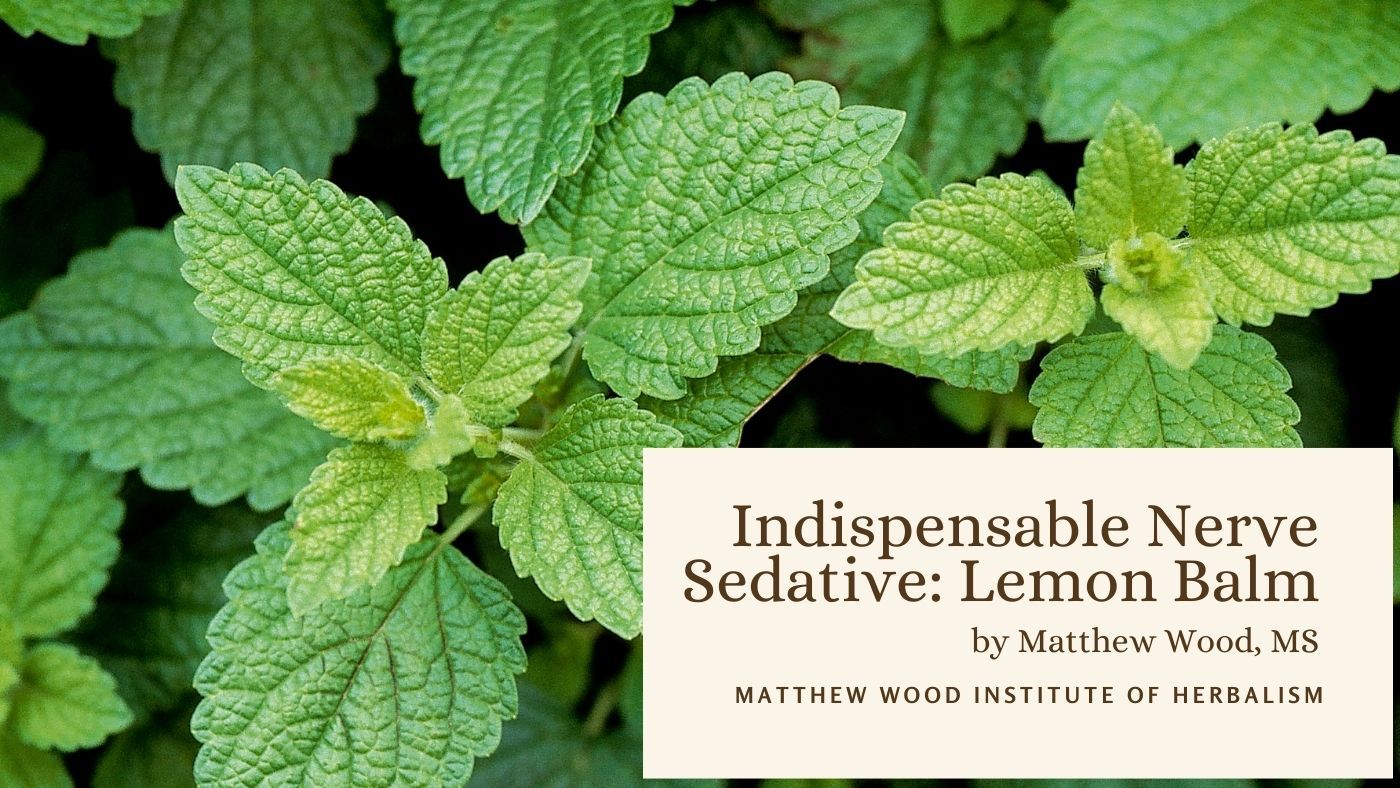VI. The Indispensable Nerve Sedative.
In addition to sedating and calming the nervous system on a deep level, as we are able to do with borage, we need to be able to calm and relax conditions of mild nervousness and upset. The sour lemon balm is cooling, in addition to relaxing, and therefore sedates through reducing the excitation of heat as well as nervousness.
Melissa officinalis. Lemon Balm.
Melissa is a member of the mint family native to Europe but widely cultivated for its pleasant lemon scent and taste. It is one of the few aromatic mints which is sour and cooling. It occupied a position of considerable importance in European domestic medicine for the last several centuries. Until recently, many households had a bottle of melissengeist or ‘spirit of melissa’ on hand as a basic nerve sedative. Melissa contains flavonoids, triterpenes, and volatile oils (including citronella).
Lemon balm has a sour taste, as its name indicates – it is one of the few sour mints. Like most sour plants, it is cooling and sedative. It combines this property with the typical nerve-calming powers of the mint family to make a strong, but safe and simple sedative. These powers are much more marked when the plant is tinctured fresh. A tincture of fresh melissa should be on the shelf in every household as a general sedative.
Melissa is a general remedy for some and a specific for others. While it will generally sedate most people, it is particularly suited to conditions of sympathetic excess, hyperadrenalinism, or hyperthyroidism. It is especially indicated when these tendencies are associated with the stomach or heart. Heart palpitations, atrial fibrillation, high blood pressure, and even aneurysm have found a remedy in melissa. It is sometimes combined with Lycopus in hyperthyroidism or is specific by itself. Keynote symptoms include sweaty palms (an indication for nervousness or sympathetic excess), a rapid or superficial pulse, and an elongated, pointed, red tongue.
In addition to being cooling, sedative, and calming, melissa is diaphoretic, so it is applicable in fevers with nervousness and in the fevers of young children. It is also used in nervous depression following exhaustive fevers and for convalescence when the digestion has been long irritated.
Taste: sour, cool
Tissue State: excitation
Specific Indications
Mind, Senses, Nerves, Emotions, Personality
Respiration
Thyroid and Heart
Digestion
Fevers
Female
Skin
Preparation and dosage: “Fresh balm is much better than dry, for it loses its fragrancy in drying” (John Hill, 1740, 70). The tea or tincture should be made from fresh leaves. Dosage of the tincture can be small (1-3 drops) to large (10-30 drops). The oil can also be used.
Looking to learn more about topics in this blog? Check out these great A-Z Herbal Classes.
"In a busy practice covering over twenty-five years and tens of thousands of clients, a person learns what remedies are of invaluable service. I would like to share my selection – herbs I choose and herbs that choose me."
Melissa officinalis. Lemon Balm.
Melissa is a member of the mint family native to Europe but widely cultivated for its pleasant lemon scent and taste. It is one of the few aromatic mints which is sour and cooling. It occupied a position of considerable importance in European domestic medicine for the last several centuries. Until recently, many households had a bottle of melissengeist or ‘spirit of melissa’ on hand as a basic nerve sedative. Melissa contains flavonoids, triterpenes, and volatile oils (including citronella).
Lemon balm has a sour taste, as its name indicates – it is one of the few sour mints. Like most sour plants, it is cooling and sedative. It combines this property with the typical nerve-calming powers of the mint family to make a strong, but safe and simple sedative. These powers are much more marked when the plant is tinctured fresh. A tincture of fresh melissa should be on the shelf in every household as a general sedative.
Melissa is a general remedy for some and a specific for others. While it will generally sedate most people, it is particularly suited to conditions of sympathetic excess, hyperadrenalinism, or hyperthyroidism. It is especially indicated when these tendencies are associated with the stomach or heart. Heart palpitations, atrial fibrillation, high blood pressure, and even aneurysm have found a remedy in melissa. It is sometimes combined with Lycopus in hyperthyroidism or is specific by itself. Keynote symptoms include sweaty palms (an indication for nervousness or sympathetic excess), a rapid or superficial pulse, and an elongated, pointed, red tongue.
In addition to being cooling, sedative, and calming, melissa is diaphoretic, so it is applicable in fevers with nervousness and in the fevers of young children. It is also used in nervous depression following exhaustive fevers and for convalescence when the digestion has been long irritated.
Taste: sour, cool
Tissue State: excitation
Specific Indications
Mind, Senses, Nerves, Emotions, Personality
- Nervousness, depression, anxiety, panic attacks, insomnia.
- Debility and weakness of nervous origin.
- Nervous headache (cold infusion).
Respiration
- Spasm in the upper respiratory centers, convulsive coughing, asthma.
Thyroid and Heart
- Anxiety and palpitations; hyperthyroidism.
- Heart palpitations, atrial fibrillation, and high blood pressure associated with nervousness.
- Pulse rapid or superficial.
Digestion
- Elongated, pointed, red tongue.
- Dyspepsia, upset stomach, flatulence.
- Nervous indigestion (hot tea after a meal).
- Nausea and vomiting.
Fevers
- Recent colds and fevers (hot tea, to promote perspiration).
- Acute febrile conditions in children.
- Depression following exhaustive fevers and long irritation of the digestion.
Female
- Conception: said to promote.
- Menstruation: deficient and painful.– Leucorrhea.
- Menopause: hot flashes (combine with peach leaf).
- Excessive sexual excitement.
Skin
- Burns, blisters, herpetic sores, stings and burns; burning, nettling pain (external).
- Sweaty palms.
Preparation and dosage: “Fresh balm is much better than dry, for it loses its fragrancy in drying” (John Hill, 1740, 70). The tea or tincture should be made from fresh leaves. Dosage of the tincture can be small (1-3 drops) to large (10-30 drops). The oil can also be used.
Looking to learn more about topics in this blog? Check out these great A-Z Herbal Classes.
"In a busy practice covering over twenty-five years and tens of thousands of clients, a person learns what remedies are of invaluable service. I would like to share my selection – herbs I choose and herbs that choose me."
References
Traditional, Humberto Santillo, Rudolf Weiss, Nalda Gosling (14), W. T. Fernie (3, 10), Ben Charles Harris (12), Franz Husemann and Otto Wolff (4., 16, 17), Wilhelm Pelikan (11, 14, 19), Sondra Boyd (18), Matthew Wood (7, 8, 20).
Selections from The Earthwise Herbal By Matthew Wood MS published by North Atlantic Books, in two volumes, 2008-9
Traditional, Humberto Santillo, Rudolf Weiss, Nalda Gosling (14), W. T. Fernie (3, 10), Ben Charles Harris (12), Franz Husemann and Otto Wolff (4., 16, 17), Wilhelm Pelikan (11, 14, 19), Sondra Boyd (18), Matthew Wood (7, 8, 20).
Selections from The Earthwise Herbal By Matthew Wood MS published by North Atlantic Books, in two volumes, 2008-9
**Disclaimer**
The information provided in this digital content is not medical advice, nor should it be taken or applied as a replacement for medical advice. Matthew Wood, the Matthew Wood Institute of Herbalism, ETS Productions, and their employees, guests, and affiliates assume no liability for the application of the information discussed.
The information provided in this digital content is not medical advice, nor should it be taken or applied as a replacement for medical advice. Matthew Wood, the Matthew Wood Institute of Herbalism, ETS Productions, and their employees, guests, and affiliates assume no liability for the application of the information discussed.


